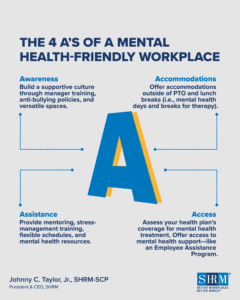
As the holidays approach, mental health is critical to employee well-being and organizational success in today’s fast-paced work environment. Employers can enhance productivity, reduce absenteeism, and create a more supportive and inclusive culture by fostering mental health-friendly workplaces. Achieving this involves increasing awareness, providing accommodations, offering assistance, and improving access to mental health resources. Below, we explore these pillars and provide actionable examples.
- Increasing Awareness
Creating awareness is the first step in reducing stigma and promoting mental health. Employers can do this through education and open communication.
- Host Mental Health Workshops and Training: Regular sessions that educate employees on recognizing signs of mental health challenges and how to support colleagues can make a significant difference. For example, a company might partner with mental health professionals to conduct stress management and resilience webinars.
- Recognize Mental Health Days: Encouraging employees to take time off for mental wellness, similar to physical health days, normalizes the importance of mental well-being.
- Internal Campaigns: Launch campaigns, such as “Mental Health Matters,” that use newsletters, posters, and social media to share tips, resources, and personal stories.
- Providing Accommodations
Workplace accommodations for mental health are just as vital as those for physical health. These adjustments can help employees manage their mental health while fulfilling their job responsibilities.
- Flexible Work Schedules: Allow employees to adjust their work hours to attend therapy sessions or manage symptoms. For instance, a company could offer a hybrid work policy that enables employees to work from home when needed.
- Quiet Spaces: Designate quiet areas for employees to decompress during stressful times. A tech company might create a “wellness room” with calming colors, soft lighting, and meditation tools.
- Workload Management: Managers can collaborate with employees to redistribute tasks during particularly challenging periods, ensuring that productivity is maintained without overwhelming the individual.
- Offering Assistance
Direct assistance programs provide immediate support for employees dealing with mental health challenges.
- Employee Assistance Programs (EAPs): Many companies offer confidential counseling services through EAPs. For example, an organization might provide free access to licensed therapists for short-term consultations.
- Peer Support Networks: Encourage employees to join or establish peer-led groups focused on mental health. For instance, a finance firm could create a “Wellness Allies” team where employees share experiences and coping strategies.
- Manager Training: Equip managers with tools to recognize and address mental health concerns among their team members. Training programs might include role-playing scenarios and guidelines on having empathetic conversations.
- Improving Access to Resources
Enhancing access ensures employees can easily find and use mental health support when needed.
- Comprehensive Health Insurance: Offer plans with robust mental health coverage, such as therapy sessions, psychiatric consultations, and medication.
- Onsite or Virtual Counseling: Partner with mental health providers to deliver onsite counseling or teletherapy options. For example, a healthcare company could arrange monthly onsite visits by a licensed therapist.
- Resource Portals: Create an online repository of mental health resources, such as articles, videos, and hotline numbers. A marketing agency might integrate this portal into its intranet for easy employee access.
Conclusion
By increasing awareness, making accommodations, assisting, and improving access, organizations can cultivate a culture that values mental health as much as physical health. These strategies support employees’ well-being and enhance engagement, loyalty, and overall organizational success. Businesses prioritizing mental health set a powerful example, proving that care and compassion are integral to thriving workplaces.
Reference: SHRM.org
